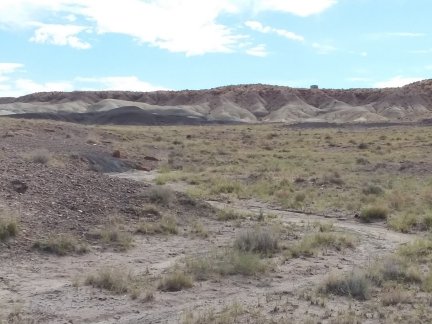 09/28/18 - Petrified Wood Hunting in Arizona
09/28/18 - Petrified Wood Hunting in Arizona
During my recent vacation to my remote Arizona property, I went back out to my secret badlands location to collect some more petrified wood. I love the badlands. It's an amazing landscape. See also
my Nebraska White River Badlands fossil hunting adventure lower on this page.
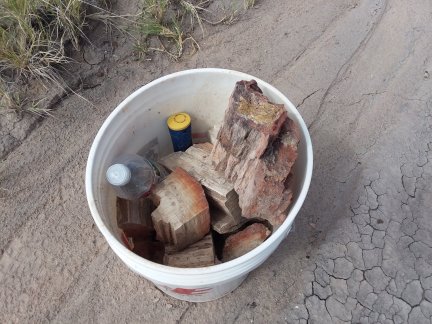 I went a little nuts this time. I collected about 50 pounds of petrified wood. That bucket is really heavy, and I carried another big chunk out too that wouldn't fit in the bucket.
I went a little nuts this time. I collected about 50 pounds of petrified wood. That bucket is really heavy, and I carried another big chunk out too that wouldn't fit in the bucket.
While I was in a rock collecting mood, I drove to Holbrook to do my laundry and root around in the rock shops there. I bought a couple of big geodes and some really pretty pieces of rainbow petrified wood that I am
going to try to cut and polish up myself. Fortunately, I took the nice, expensive rocks home in my checked baggage (see below).
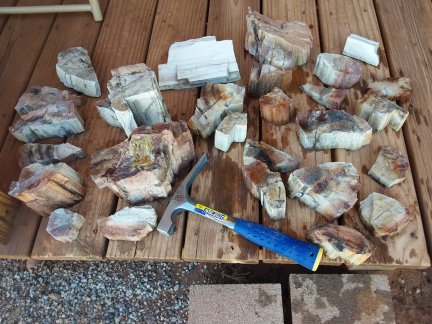 So here is the day's haul of petrified wood after washing all the mud and clay off of it. Yes, I went a little crazy with the collecting that day. I plan on keeping some of it for myself to display and try polishing.
The rest I plan on donating to be auctioned or raffled off at various Fossil Club fund raising events.
So here is the day's haul of petrified wood after washing all the mud and clay off of it. Yes, I went a little crazy with the collecting that day. I plan on keeping some of it for myself to display and try polishing.
The rest I plan on donating to be auctioned or raffled off at various Fossil Club fund raising events.
I mailed about two thirds of this wood home to myself. I wrapped the pieces in bubble wrap and filled up two large flat-rate boxes with them. I took great care wrapping and cushioning the pieces. Unfortunately
the post office did not take such great care in delivering them. The boxes arrived at my home looking like they had been run over by a truck, several times. Some of the pieces got pulverized. Naturally it was
some of the most interesting looking pieces that got damaged. I still have lots of petrified wood to play around with though. I just keep reminding myself that I didn't pay anything for it, so I'm not out anything. I'll
probably use FedEx next time though.
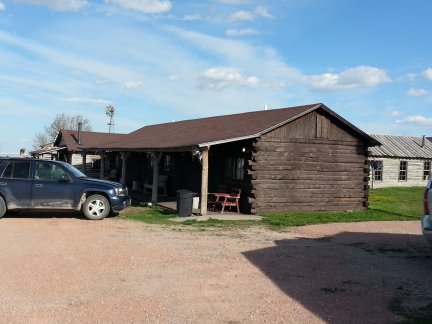 05/16/18 - A Nebraska Badlands Fossil Adventure
05/16/18 - A Nebraska Badlands Fossil Adventure
Earlier this month I was invited along on an invitation only trip to fossil hunt in the famous White River Badlands of Nebraska with an elite group of people from the Tampa Bay Fossil Club.
A group of them goes out there every year to dig for fossils. The things they find there are amazing. I was honored to be asked to go along. I learned a lot and had a really great time. This area
of badlands is known for producing excellent examples of Eocene and Oligocene age fossils including titanotheres,
rhinos, oriodonts,
horses and giant turtles, among many others.
While in Nebraska we stayed at The High Plains Homestead near Crawford Nebraska. The Homestead is a really neat place. The Homestead is as close to
the middle of nowhere as you could get. It takes navigating miles and miles of dirt roads through the badlands to get to it. The accommodations are rustic, but comfortable. It sits right on
the edge of the badlands in a really beautiful spot. Cell phone service at the Homestead is nearly non-existent, which is nice because it kept work from bugging me all week. There is a hill a few miles
away called Mother's Day Hill where the service is ok and everyone goes to make cell phone calls. The place got it's name from everyone going there on Mother's day to call their moms. The Homestead
is really a neat place. It's like being transported back in time to an earlier age where everyone wasn't addicted to their devices 24/7.
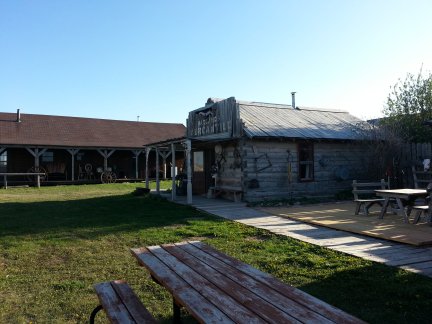 The Homestead is a guest ranch and restaurant. It has lots of cabins and bunkhouses to stay in. There is a cookshack where most meals are served. There is a working saloon where drinks and meals can also be
served. There are a lot of other old buildings too. There is a barn, a blacksmith's shop, a mercantile store, an old schoolhouse, a sheriff's office, a jail, a post office, a bath house and a livery stable.
All together the place is the size of a small town. It seems like every old building for hundreds of miles around must have been moved to the Homestead. We were a group of eleven who stayed at the Homestead
for the fossil hunting this year, but we didn't even take up half the available cabins and bunkhouse space.
The Homestead is a guest ranch and restaurant. It has lots of cabins and bunkhouses to stay in. There is a cookshack where most meals are served. There is a working saloon where drinks and meals can also be
served. There are a lot of other old buildings too. There is a barn, a blacksmith's shop, a mercantile store, an old schoolhouse, a sheriff's office, a jail, a post office, a bath house and a livery stable.
All together the place is the size of a small town. It seems like every old building for hundreds of miles around must have been moved to the Homestead. We were a group of eleven who stayed at the Homestead
for the fossil hunting this year, but we didn't even take up half the available cabins and bunkhouse space.
 Owner of the High Plains Homestead Mike Kesselring is cooking steaks for us one evening. The food at the Homestead was plentiful and excellent. This was one of the best steaks I have ever eaten. Plus it was huge.
I couldn't finish it all. They really fed us well at the Homestead. A week of huge meals was also very reasonably priced.
Owner of the High Plains Homestead Mike Kesselring is cooking steaks for us one evening. The food at the Homestead was plentiful and excellent. This was one of the best steaks I have ever eaten. Plus it was huge.
I couldn't finish it all. They really fed us well at the Homestead. A week of huge meals was also very reasonably priced.
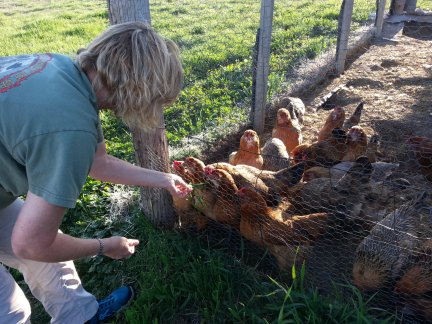 Here my Girlfriend is feeding the chickens at the Homestead. They are the source of the fresh eggs for the breakfasts every morning. The Homestead is as self-sufficient as possible.
Here my Girlfriend is feeding the chickens at the Homestead. They are the source of the fresh eggs for the breakfasts every morning. The Homestead is as self-sufficient as possible.
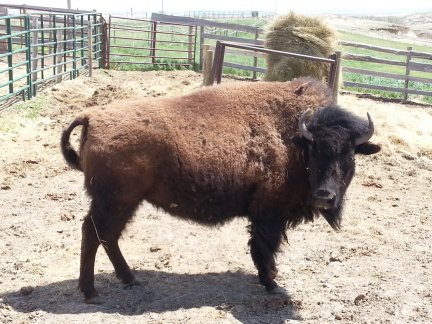 There was a buffalo in one of the corrals at the Homestead. There was lots of buffalo on the Cookshack menu. The buffalo burgers and buffalo roast were excellent. So that is likely this fellow's future fate.
There was a buffalo in one of the corrals at the Homestead. There was lots of buffalo on the Cookshack menu. The buffalo burgers and buffalo roast were excellent. So that is likely this fellow's future fate.
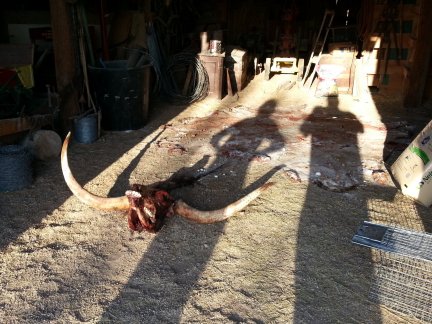 The Homestead is a working ranch as well as a guest house and restaurant. So the above steaks were likely harvested from this guy. His head and hide drying in the barn are all that are left of him.
The Homestead is a working ranch as well as a guest house and restaurant. So the above steaks were likely harvested from this guy. His head and hide drying in the barn are all that are left of him.
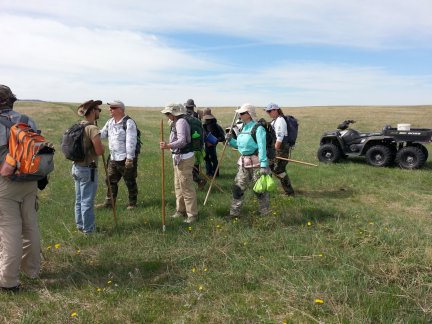 Getting ready to go fossil hunting is like prepping for a military operation. These folks are serious fossil hunters. It takes a couple of days of preparations before everything is ready. Supplies
need to be purchased. ATVs need to be rented. Trailers need to be borrowed. Liquid plastic to stabilize the fossils needs to be mixed up and decanted into individual bottles for everyone to carry.
Bags containing plaster and burlap strips need to be made up for
each person to carry in. Water bottles need to be filled and buckets for mixing plaster need to be rounded up. Backpacks need to be loaded with tools, supplies, clothing, food and drinking water to
keep us comfortable and working all day out in the badlands in any conditions from freezing rain to extreme heat (we saw both extremes while I was there). Everything has a dual use. Even the shovel handle walking
sticks we all took with us not only helped us walk on the rough and uneven surfaces of the badlands, but also doubled as handles for making slings to carry out heavy loads. They could also be used to
make stretchers to carry out injured people. The preparation and organization that goes into an expedition is amazing. Some turkey hunters staying at the Homestead watched us prepping and loading up and said it
looked like Seal Team 6 getting ready to go into battle.
Getting ready to go fossil hunting is like prepping for a military operation. These folks are serious fossil hunters. It takes a couple of days of preparations before everything is ready. Supplies
need to be purchased. ATVs need to be rented. Trailers need to be borrowed. Liquid plastic to stabilize the fossils needs to be mixed up and decanted into individual bottles for everyone to carry.
Bags containing plaster and burlap strips need to be made up for
each person to carry in. Water bottles need to be filled and buckets for mixing plaster need to be rounded up. Backpacks need to be loaded with tools, supplies, clothing, food and drinking water to
keep us comfortable and working all day out in the badlands in any conditions from freezing rain to extreme heat (we saw both extremes while I was there). Everything has a dual use. Even the shovel handle walking
sticks we all took with us not only helped us walk on the rough and uneven surfaces of the badlands, but also doubled as handles for making slings to carry out heavy loads. They could also be used to
make stretchers to carry out injured people. The preparation and organization that goes into an expedition is amazing. Some turkey hunters staying at the Homestead watched us prepping and loading up and said it
looked like Seal Team 6 getting ready to go into battle.
Here we are forming up to march into the badlands. We had driven as far as we could in our 4X4 trucks towing the ATVs. Then we used the ATVs to ferry people and supplies as close as we could get in vehicles.
The last half mile or so we had to walk while carrying everything.
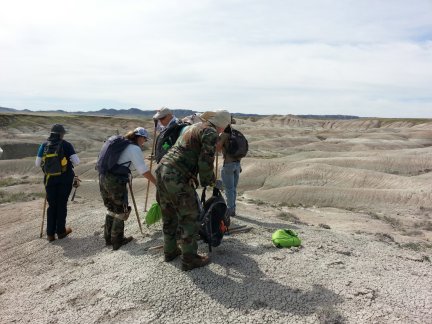 Once we reached the badlands we created a staging area on a high point visible from all directions. we dropped off the bags containing plaster and burlap and water and buckets for mixing plaster here until
they were needed. No point in carrying all that extra weight around until a fossil is found that needs to be jacketed in plaster. The staging area would be the rallying point where we would all gather at
the end of the day or if the weather turned bad and we needed to leave early. Rain makes the badlands as slick as if they are covered in axle grease. Walking and climbing becomes difficult to say the least.
The roads out become impassible real quick. We'd need to get out in a hurry if the weather turned bad. Then we split up and went off searching for fossils. We had strict
instructions on where the limits of our travels were and we all had walkie-talkies to keep in touch with each other.
Once we reached the badlands we created a staging area on a high point visible from all directions. we dropped off the bags containing plaster and burlap and water and buckets for mixing plaster here until
they were needed. No point in carrying all that extra weight around until a fossil is found that needs to be jacketed in plaster. The staging area would be the rallying point where we would all gather at
the end of the day or if the weather turned bad and we needed to leave early. Rain makes the badlands as slick as if they are covered in axle grease. Walking and climbing becomes difficult to say the least.
The roads out become impassible real quick. We'd need to get out in a hurry if the weather turned bad. Then we split up and went off searching for fossils. We had strict
instructions on where the limits of our travels were and we all had walkie-talkies to keep in touch with each other.
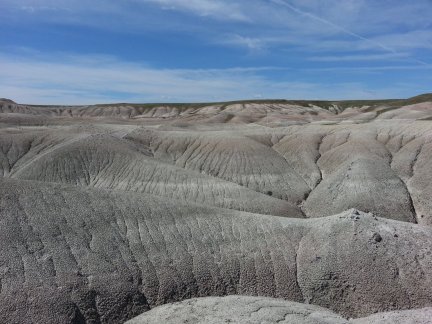 How to describe the badlands to someone who has never been there? Stark, rugged, difficult, silent, almost lifeless. Nothing grows there. But also surprisingly beautiful, colorful and serene. It is a three-dimensional terrain
that is very difficult to get around in if
you can't fly. Getting from one point to another requires finding a path that isn't too steep to climb up or down. Sometimes you arrive at a dead-ends where there is either a steep drop or a sheer wall in front of you
and you have to backtrack to find a less difficult path. All the while you are walking you need to be scanning the ground and hills around you for bits of exposed bone. They usually aren't anything but an isolated
piece of bone, but sometimes they are the tip of something big still buried. Sometimes a trail of bones going down a hill can be traced back to a skeleton that is eroding out higher up.
How to describe the badlands to someone who has never been there? Stark, rugged, difficult, silent, almost lifeless. Nothing grows there. But also surprisingly beautiful, colorful and serene. It is a three-dimensional terrain
that is very difficult to get around in if
you can't fly. Getting from one point to another requires finding a path that isn't too steep to climb up or down. Sometimes you arrive at a dead-ends where there is either a steep drop or a sheer wall in front of you
and you have to backtrack to find a less difficult path. All the while you are walking you need to be scanning the ground and hills around you for bits of exposed bone. They usually aren't anything but an isolated
piece of bone, but sometimes they are the tip of something big still buried. Sometimes a trail of bones going down a hill can be traced back to a skeleton that is eroding out higher up.
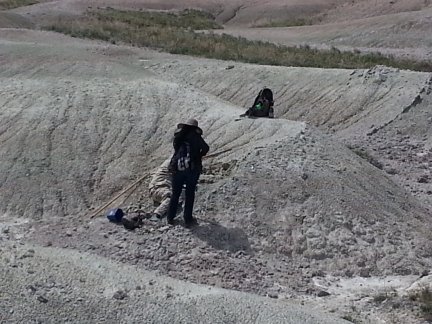 Albert spotted some bone protruding from the side of a small hill. After some careful excavation he found it was the jaw of a titanothere.
He stabilized it with liquid plastic and began carefully digging around the bones to allow for jacketing the find in plaster and burlap to remove it with minimal damage.
Albert spotted some bone protruding from the side of a small hill. After some careful excavation he found it was the jaw of a titanothere.
He stabilized it with liquid plastic and began carefully digging around the bones to allow for jacketing the find in plaster and burlap to remove it with minimal damage.
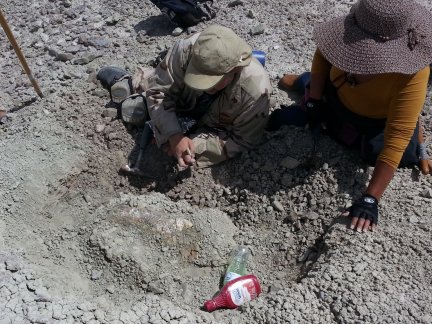 Here is a closer view of Albert's find. The titanothere jaw bones are shiny tan in color against the gray clay of the badlands. The shine comes from the liquid plastic (Butvar) that has been applied to the bones to
stabilize them. Albert will carefully dig all around the bones until they stand on a pedestal of soil. Then he will jacket them first with aluminum foil, then with plaster soaked burlap strips.
Here is a closer view of Albert's find. The titanothere jaw bones are shiny tan in color against the gray clay of the badlands. The shine comes from the liquid plastic (Butvar) that has been applied to the bones to
stabilize them. Albert will carefully dig all around the bones until they stand on a pedestal of soil. Then he will jacket them first with aluminum foil, then with plaster soaked burlap strips.
As Albert works his wife Teresa is taking a break from fossil hunting herself to check his progress.
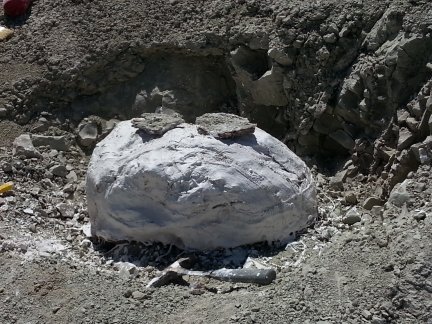 Here is Albert's completed jacketing job of the jaw bones he found. Now the pedestal of soil can be undermined and the jacket flipped over. The bones and soil and rock around them will remain encased in the jacket
and won't be damaged as it is hauled out of the badlands. Once back home Albert, or an expert of his choosing, can carefully liberate the bones from the rock and soil matrix. Any damage can be repaired and the
jaw can be reconstructed. We don't know just how much of the animal's jaws are present inside the jacket. They may be complete or there may be pieces missing. Only time and careful work will tell.
Here is Albert's completed jacketing job of the jaw bones he found. Now the pedestal of soil can be undermined and the jacket flipped over. The bones and soil and rock around them will remain encased in the jacket
and won't be damaged as it is hauled out of the badlands. Once back home Albert, or an expert of his choosing, can carefully liberate the bones from the rock and soil matrix. Any damage can be repaired and the
jaw can be reconstructed. We don't know just how much of the animal's jaws are present inside the jacket. They may be complete or there may be pieces missing. Only time and careful work will tell.
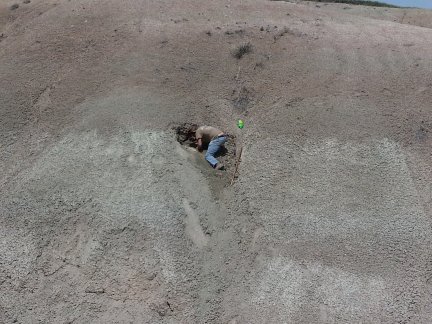 Joe spotted some bone high up on the side of a very steep hill. After doing some careful excavating he found that it was a pair of titanothere ribs. This photo was taken from atop a nearby hill. The place where
Joe is digging is a nearly vertical wall. Joe climbs like a monkey.
Joe spotted some bone high up on the side of a very steep hill. After doing some careful excavating he found that it was a pair of titanothere ribs. This photo was taken from atop a nearby hill. The place where
Joe is digging is a nearly vertical wall. Joe climbs like a monkey.
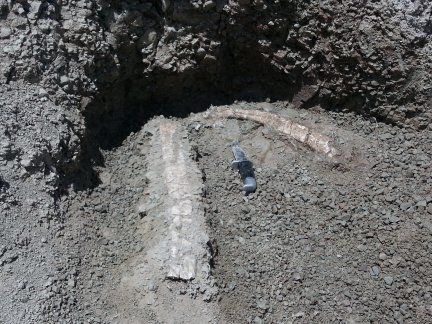 Here is a close-up of the titanothere ribs Joe found high up on the side of a near vertical hill. I had to chop steps into the hill to haul myself up to look at and photograph is find. Joe stabilized the ribs with Butvar
and then jacketed them for removal.
Here is a close-up of the titanothere ribs Joe found high up on the side of a near vertical hill. I had to chop steps into the hill to haul myself up to look at and photograph is find. Joe stabilized the ribs with Butvar
and then jacketed them for removal.
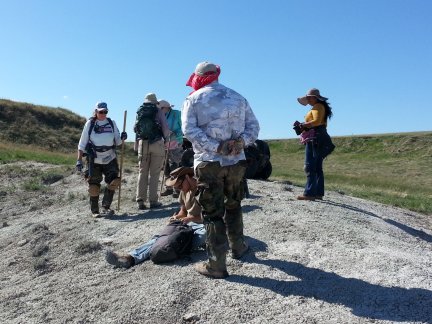 At the end of this first day we tired fossil hunters gathered at the rally point and began the process of ferrying ourselves and our equipment and our finds back out. It had been a brutally hot day. We were
all beat and footsore. Cold drinks awaited in the coolers back at the trucks. We couldn't wait to get to them, and another excellent dinner back at the Homestead. It had been an exhausting but fun and
educational day.
At the end of this first day we tired fossil hunters gathered at the rally point and began the process of ferrying ourselves and our equipment and our finds back out. It had been a brutally hot day. We were
all beat and footsore. Cold drinks awaited in the coolers back at the trucks. We couldn't wait to get to them, and another excellent dinner back at the Homestead. It had been an exhausting but fun and
educational day.
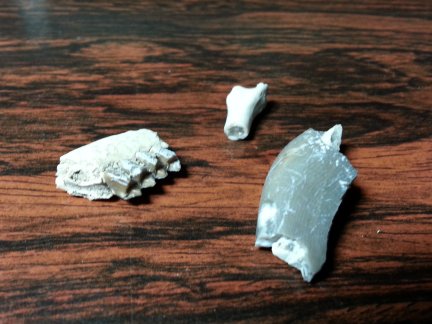 My own finds were modest that day. I was one of the newbies in the group and had never hunted the badlands before. I wasn't yet used to the way fossils look out there, compared to Florida fossils. There isn't much
contrast between the fossilized bone and the badlands soil. I was determined to get the hang of it though.
My own finds were modest that day. I was one of the newbies in the group and had never hunted the badlands before. I wasn't yet used to the way fossils look out there, compared to Florida fossils. There isn't much
contrast between the fossilized bone and the badlands soil. I was determined to get the hang of it though.
My finds for the day consisted of a section of jawbone with some teeth still in place, possibly from a dwarf deer-like creature. I also found an interesting piece of bone with the marrow channel filled with crystal.
I also recovered a few shards of rhino tooth. I also did the usual newbie thing of collecting lots of misc. bone fragments and bits of turtle shell that really aren't worth anything. After weighing myself down
with a few pounds of that stuff I started to learn to just keep the interesting stuff. That pretty much rounded out my first day in the badlands. I learned a lot that first day and vowed to do better in the
future.
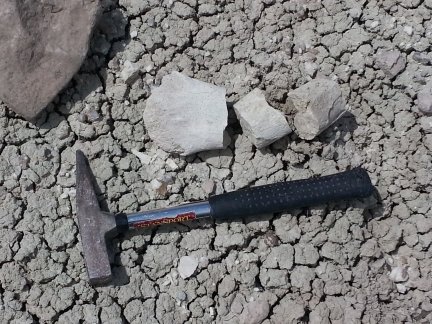 The next day couldn't have been more different from the first. It dawned cold, windy and threatening rain. We went to a different area of the badlands on this day. Almost immediately my girlfriend and
I spotted this very large broken bone. She also quickly found a section
of jaw bone with teeth in it, probably from an oriodont. Neither of us found much the day before. It was looking like we were going to have a better day, as long as the rains held off.
The next day couldn't have been more different from the first. It dawned cold, windy and threatening rain. We went to a different area of the badlands on this day. Almost immediately my girlfriend and
I spotted this very large broken bone. She also quickly found a section
of jaw bone with teeth in it, probably from an oriodont. Neither of us found much the day before. It was looking like we were going to have a better day, as long as the rains held off.
Things didn't pan out like we hoped. After hours of looking and miles of walking, neither of us was finding much. I was becoming adept at spotting rhino tooth fragments in the washes and was accumulating a collection of them.
Other than that I wasn't finding much. Neither was almost anyone else. All the while the weather was steadily deteriorating. Rain was coming and we would need to leave quickly when it arrived before the
roads became impassible.
 A little after midday, I met up with my girlfriend again. We sat down and had lunch and a rest. Then we decided to go see what her son Joe was doing. He had found a
good site to dig on a previous expedition to this area and went back there again first thing this morning. So we trudged a mile or so over to where he was. It felt more like five miles as we had to jink our
way across the crazy landscape of the badlands to get there. Along the way I found a large chunk of turtle carapace. It was a neat find from what must have been a very large turtle. Unfortunately I couldn't
find any other parts of the animal.
A little after midday, I met up with my girlfriend again. We sat down and had lunch and a rest. Then we decided to go see what her son Joe was doing. He had found a
good site to dig on a previous expedition to this area and went back there again first thing this morning. So we trudged a mile or so over to where he was. It felt more like five miles as we had to jink our
way across the crazy landscape of the badlands to get there. Along the way I found a large chunk of turtle carapace. It was a neat find from what must have been a very large turtle. Unfortunately I couldn't
find any other parts of the animal.
We arrived at Joe's dig site and found Bill there digging too off to his right a bit. Both were finding bones. Joe was finding rhino ribs and Bill was finding titanothere vertebrae and other bones. From a distance it was easy
to see that they were both digging at exactly the same level of the strata. It looked like that was a good level to dig.
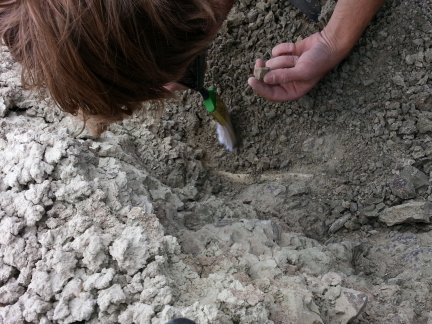 Joe's seeming ability to find rib bones everywhere he went earned him the name "rib man," and jokes about needing to carry BBQ sauce with him. Here he is brushing dirt away from a rhino rib. He just kept finding
more and more of them. As he dug out one he'd spot the end of another.
Joe's seeming ability to find rib bones everywhere he went earned him the name "rib man," and jokes about needing to carry BBQ sauce with him. Here he is brushing dirt away from a rhino rib. He just kept finding
more and more of them. As he dug out one he'd spot the end of another.
I decided to try doing some exploratory digging nearby at the same level. After a bit of digging I found a small bone sticking out of the hill. I excavated around it as best I could (I don't yet have the finesse of
some of the others) and found more bones and turtle scutes. Due to my lack of finesse, I managed to pretty much destroy the turtle trying to dig it out. I have the pieces though. I may try to glue the parts
I have back together.
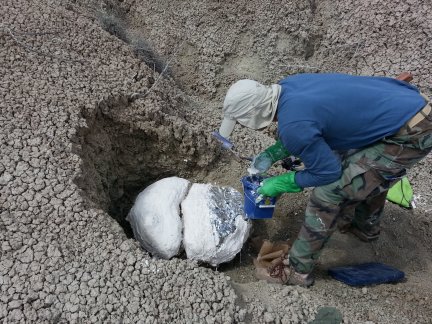 Bill was rushing to complete plaster jackets around his titanothere finds. The weather was starting to look ugly. We were going to need to leave soon. We built slings from our walking sticks and a cargo net, and
it took four of us to carry his largest jacket out to where we could get it in an ATV in to take it back to the trucks. By then the wind was blowing at gale force, the temperature had plummeted and it was spitting rain.
We got out of the badlands just in time. The rain eventually turned the roads into quagmires of slick mud that even 4X4 trucks couldn't navigate.
Bill was rushing to complete plaster jackets around his titanothere finds. The weather was starting to look ugly. We were going to need to leave soon. We built slings from our walking sticks and a cargo net, and
it took four of us to carry his largest jacket out to where we could get it in an ATV in to take it back to the trucks. By then the wind was blowing at gale force, the temperature had plummeted and it was spitting rain.
We got out of the badlands just in time. The rain eventually turned the roads into quagmires of slick mud that even 4X4 trucks couldn't navigate.
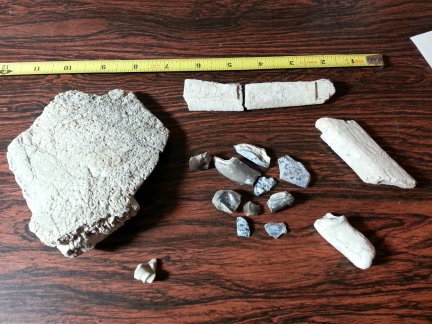 My finds for the second day consisted of the large piece of turtle carapace (It must have been a really big turtle), some fragments of a large, broken rib, lots of rhino and titanothere tooth fragments, and what looks
like a toe bone from something. I also have a bag full of bones and scutes from the soft-shell turtle I found.
My finds for the second day consisted of the large piece of turtle carapace (It must have been a really big turtle), some fragments of a large, broken rib, lots of rhino and titanothere tooth fragments, and what looks
like a toe bone from something. I also have a bag full of bones and scutes from the soft-shell turtle I found.
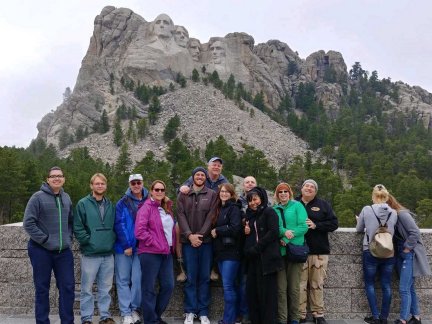 The next few days were rainy, foggy and very cold. There was no hope of fossil hunting in the badlands under those conditions. So we decided to go exploring. We went to a local rock shop where I bought a whole bunch
of stuff to bring home and polish up. We went to a local honey store where I bought a couple bottles of their excellent buckwheat honey. I love that stuff in my morning tea. We then drove up into South Dakota to see Mt. Rushmore.
At first it seemed like a wasted trip. The rain, fog and clouds totally obscured the mountain. We couldn't see anything at all. Then, like a miracle, the clouds began parting. Soon there was a clear view. We furiously snapped
photos while the clearing lasted. After only maybe 20 minutes it was back to being totally obscured and raining again.
The next few days were rainy, foggy and very cold. There was no hope of fossil hunting in the badlands under those conditions. So we decided to go exploring. We went to a local rock shop where I bought a whole bunch
of stuff to bring home and polish up. We went to a local honey store where I bought a couple bottles of their excellent buckwheat honey. I love that stuff in my morning tea. We then drove up into South Dakota to see Mt. Rushmore.
At first it seemed like a wasted trip. The rain, fog and clouds totally obscured the mountain. We couldn't see anything at all. Then, like a miracle, the clouds began parting. Soon there was a clear view. We furiously snapped
photos while the clearing lasted. After only maybe 20 minutes it was back to being totally obscured and raining again.
This is a group photo of all eleven of us who went on this year's Nebraska Fossil adventure.
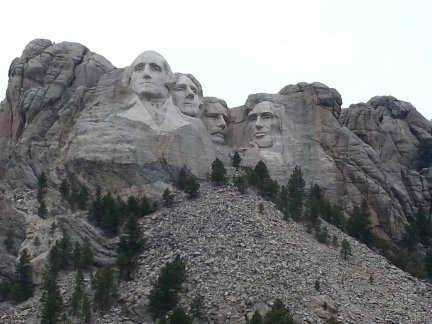 Here is a view of Mt. Rushmore from the main viewing platform. North by Northwest has always been one of my favorite movies. It was great to see the location where the climactic scenes of the film
were shot.
Here is a view of Mt. Rushmore from the main viewing platform. North by Northwest has always been one of my favorite movies. It was great to see the location where the climactic scenes of the film
were shot.
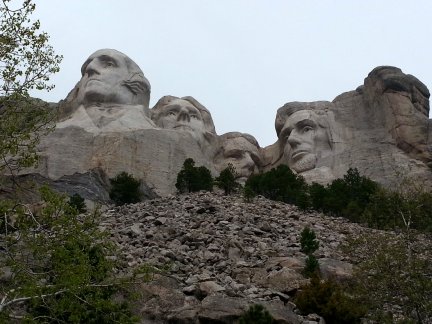 Here is a view of Mt. Rushmore from the base of the mountain. I can almost see Martin Landau chasing Cary Grant and Eva Marie Saint across the faces.
Here is a view of Mt. Rushmore from the base of the mountain. I can almost see Martin Landau chasing Cary Grant and Eva Marie Saint across the faces.
 Here is a selfie I took of me and my girlfriend in front of Mt. Rushmore. It is an awesome place. I'm so glad the weather cleared for a bit while we were there. Shortly after this photo was taken the mist and rain
moved in again and the mountain was totally obscured again. We overheard a ranger at the museum call the front gate and say "The boys are being bashful," which is code for the rangers to let people know
as they enter the gate that they may not be able to see anything.
Here is a selfie I took of me and my girlfriend in front of Mt. Rushmore. It is an awesome place. I'm so glad the weather cleared for a bit while we were there. Shortly after this photo was taken the mist and rain
moved in again and the mountain was totally obscured again. We overheard a ranger at the museum call the front gate and say "The boys are being bashful," which is code for the rangers to let people know
as they enter the gate that they may not be able to see anything.
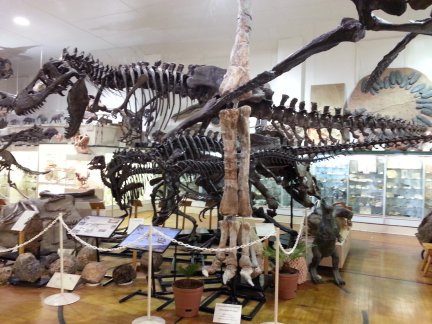 After seeing Mt. Rushmore we went to the Black Hills Institute to see their impressive collection of Fossils. These are the people who found the famous Tyrannosaurus Sue, and had it seized from them in shady
legal proceedings. The story can be found on their web site. It is a really interesting place. The fossils on display are amazing.
After seeing Mt. Rushmore we went to the Black Hills Institute to see their impressive collection of Fossils. These are the people who found the famous Tyrannosaurus Sue, and had it seized from them in shady
legal proceedings. The story can be found on their web site. It is a really interesting place. The fossils on display are amazing.
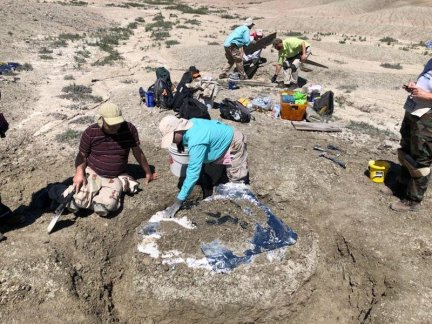 Unfortunately I had to leave the next day. I only had a little over a week there before I had to return to Florida and work. The rest of the group would be staying for another week. The weather kept them from going back
into the badlands for a few days. Once they did go back they tackled trying to recover a very large turtle that was located by the owner of the land we were digging on. Look at the size of that thing.
Unfortunately I had to leave the next day. I only had a little over a week there before I had to return to Florida and work. The rest of the group would be staying for another week. The weather kept them from going back
into the badlands for a few days. Once they did go back they tackled trying to recover a very large turtle that was located by the owner of the land we were digging on. Look at the size of that thing.
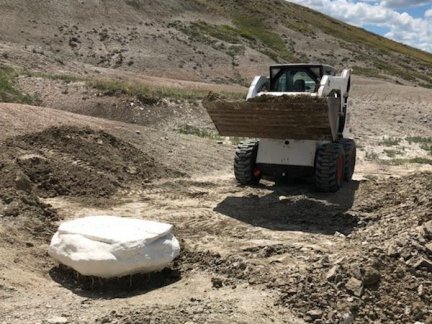 Once the monster turtle was jacketed they needed to use a Bobcat Loader to move it out of the badlands. Unfortunately there wasn't as much left of the turtle as everyone hoped. Most of the carapace had eroded
away. All that was left was the plastron and some bones. Too bad because it would have been an amazing specimen.
Once the monster turtle was jacketed they needed to use a Bobcat Loader to move it out of the badlands. Unfortunately there wasn't as much left of the turtle as everyone hoped. Most of the carapace had eroded
away. All that was left was the plastron and some bones. Too bad because it would have been an amazing specimen.
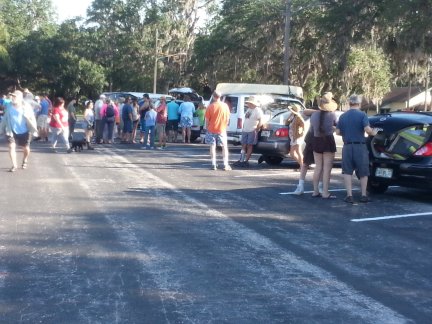 4/27/18 - 4/29/18 - The 2018 Peace River Adventure
4/27/18 - 4/29/18 - The 2018 Peace River Adventure
My girlfriend and I participated in the Tampa Bay Fossil Club's annual Peace River Adventure fossil hunt. We camped at Pioneer Campground for a few days and went out on the big group fossil hunt on Saturday.
This photo shows the group starting to form up at the campground early Saturday morning for the caravan to the river. We had a huge crowd by the time everyone arrived. My Girlfriend had done this before and knew where the river access was,
so we cut out early and beat the worst of the crowd there so we could launch our kayaks and head up river.
Click on any photo for a larger view.
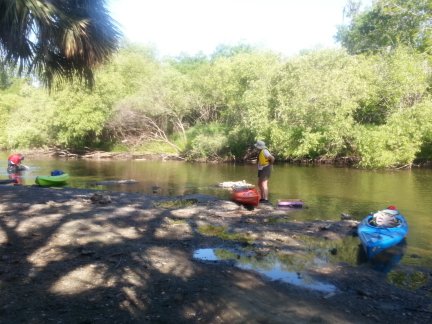 Even though we got an early start, the number of people already on the river was amazing. We are kind of used to being the only people around when we are on the river. Not this time. We paddled probably a mile upstream and never really got
away from other people. That's ok though, because being part of a group hunt was kind of fun for a change. As we paddled upstream we sampled the river gravels in various spots. Eventually we found a really productive place to dig and screen
and spent several hours there.
Even though we got an early start, the number of people already on the river was amazing. We are kind of used to being the only people around when we are on the river. Not this time. We paddled probably a mile upstream and never really got
away from other people. That's ok though, because being part of a group hunt was kind of fun for a change. As we paddled upstream we sampled the river gravels in various spots. Eventually we found a really productive place to dig and screen
and spent several hours there.
I took this photo at one of the places we stopped to sample the gravels. My blue kayak is in the foreground. My girlfriend is standing next to her kayak in the middle, and someone else is digging on the left. We spent much of the day out on the
river. We had a picnic lunch and kept digging until it was time to head back for the evening festivities. The return trip to the boat launch was a sea of people. I doubt there are many fossils left in the river near the boat launch.
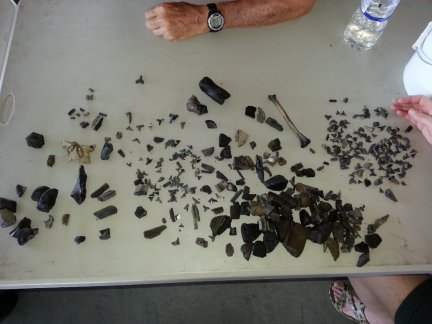 Once we got back to the campground, we headed over to the big activity pavilion where there would be a group dinner and auction later in the evening. We sorted our finds for the day on one of the tables there. Other people were sorting
through their finds too. Several very knowledgeable people circulated around the tables and helped everyone identify their finds. Sometimes spirited debates erupted about what animal a particular bone belonged to, but eventually a
consensus would form and the finder would be happy with the information.
Once we got back to the campground, we headed over to the big activity pavilion where there would be a group dinner and auction later in the evening. We sorted our finds for the day on one of the tables there. Other people were sorting
through their finds too. Several very knowledgeable people circulated around the tables and helped everyone identify their finds. Sometimes spirited debates erupted about what animal a particular bone belonged to, but eventually a
consensus would form and the finder would be happy with the information.
People were very impressed with the number and quality of our finds. We had hundreds of shark teeth, including some big ones. There was lots of bits of bone, including some pieces complete enough to identify the animal they came from.
There was a bunch of turtle shell from both hard and soft shell turtles. There were bits of tusk ivory maybe from mammoths or mastodons. A piece of mastodon tooth, and a shard of mammoth tooth. Lots of bits of various mammal teeth.
A dermal scute from a glyptodon, Lots of stingray mouth plate pieces, including some very large ones. A long and complete bird bone, which is rare to find because bird bones are so delicate and easily broken. We found a really
productive spot to dig. We'll have to go back there again.
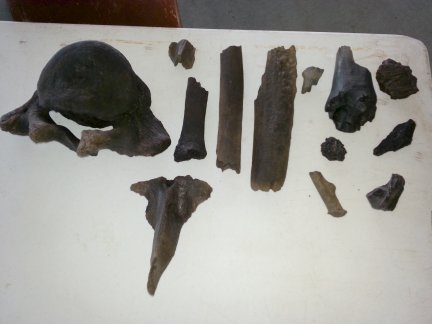 Dr. Bob Sinibaldi showed off some of the mammoth bones he found. Dr. Bob has been working the same mammoth site for quite a while. Eventually he hopes to have most of the skeleton. I have seen some of the leg bones he has recovered
so far. They look like tree trunks. Here he is showing off a vertebra and some misc. bones from the find. The vertebra is huge and heavy. The photo doesn't give any scale to how big it is.
Dr. Bob Sinibaldi showed off some of the mammoth bones he found. Dr. Bob has been working the same mammoth site for quite a while. Eventually he hopes to have most of the skeleton. I have seen some of the leg bones he has recovered
so far. They look like tree trunks. Here he is showing off a vertebra and some misc. bones from the find. The vertebra is huge and heavy. The photo doesn't give any scale to how big it is.
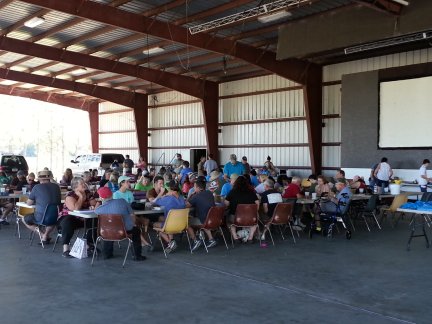 Later in the evening there was a group dinner, followed by an auction to raise money for the club. The food was good and the auction was a lot of fun. After dark we built a fire out in the campground and the there is a tradition of baking
little campfire pies for the group every year at this event. The pies were a smash hit. The weather was perfect the whole time we were there. We had fun camping. It was a really great time. Can't wait to do it again next year.
Later in the evening there was a group dinner, followed by an auction to raise money for the club. The food was good and the auction was a lot of fun. After dark we built a fire out in the campground and the there is a tradition of baking
little campfire pies for the group every year at this event. The pies were a smash hit. The weather was perfect the whole time we were there. We had fun camping. It was a really great time. Can't wait to do it again next year.
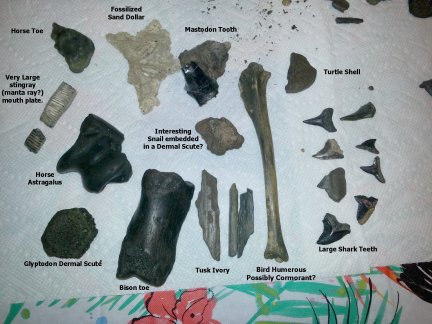 Here is a photo of our best finds from the trip. We found hundreds of bits, but this is the really good stuff. The bit of mastodon tooth was a great find. The bison and horse bones were great too. The ivory was a nice find. That leads me
to believe there might be mammoth or mastodon tusks out there yet to be found. The pieces of stingray mouth plate were the largest ones anyone had ever seen. It was suggested they may have come from a manta ray. We got some big and interesting
shark teeth too. No big meg teeth yet, but someday. There were lots of other interesting bits too, including some pieces of turtle shell with really neat vein-like patterns on them. It was my best day yet of fossil hunting on the Peace River.
I can't wait to go back.
Here is a photo of our best finds from the trip. We found hundreds of bits, but this is the really good stuff. The bit of mastodon tooth was a great find. The bison and horse bones were great too. The ivory was a nice find. That leads me
to believe there might be mammoth or mastodon tusks out there yet to be found. The pieces of stingray mouth plate were the largest ones anyone had ever seen. It was suggested they may have come from a manta ray. We got some big and interesting
shark teeth too. No big meg teeth yet, but someday. There were lots of other interesting bits too, including some pieces of turtle shell with really neat vein-like patterns on them. It was my best day yet of fossil hunting on the Peace River.
I can't wait to go back.
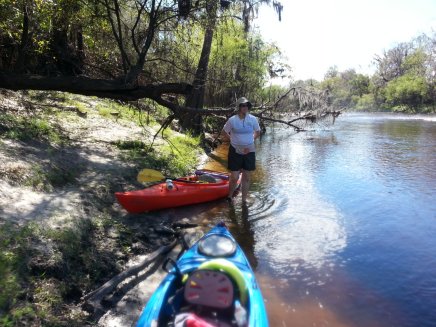 02/19/18 - A President's Day Fossil Hunt
02/19/18 - A President's Day Fossil Hunt
On Monday my girlfriend and I again went paddling up the Peace River in our kayaks to go fossil hunting. This was my first chance to really use my new (to me) kayak.
I bought it a few months ago after injuring my ankle. I haven't been able to use it (or do a lot of other things until now that it is better. It feels really good to be back out there. We had
a great day for it. The weather was wonderful. The first place we put in we paddled downstream quite a way looking for gravel banks. The water was just too high and too deep to dig in. So after
a strenuous paddle back upstream we loaded up again the kayaks and drove to another spot. This time we struck gold. A short paddle upstream brought us to some gravel banks in shallow water. We beached
the kayaks there and got down to digging and screening. In this photo my girlfriend is appraising the gravel bars in the middle of the river an stating that we should dig here.
Some of the photos like this one are a bit blurry and they are all low resolution due to us both shooting with our phones in waterproof cases.
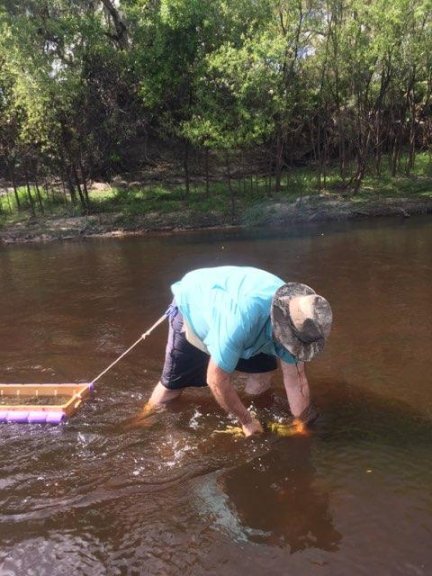 Here is a photo of me out in the middle of the river digging on a shallow gravel bar. I have the floating screen tied to my waist to prevent the ferocious current from taking it away. Even though the
water was only about knee deep, the current was very strong and could easily knock you over into the drink if not careful. I'm shoveling
gravel into the screen and washing it to get rid of sand, clay and fines. What remains is a lot of rocks and usually a fossil or two of some kind in each screen full. It's hard labor under the hot sun,
but the water is chilly, and there was a nice breeze. Anyway, it's not as had labor as paddling upstream against the current was. Digging was actually a nice break.
Here is a photo of me out in the middle of the river digging on a shallow gravel bar. I have the floating screen tied to my waist to prevent the ferocious current from taking it away. Even though the
water was only about knee deep, the current was very strong and could easily knock you over into the drink if not careful. I'm shoveling
gravel into the screen and washing it to get rid of sand, clay and fines. What remains is a lot of rocks and usually a fossil or two of some kind in each screen full. It's hard labor under the hot sun,
but the water is chilly, and there was a nice breeze. Anyway, it's not as had labor as paddling upstream against the current was. Digging was actually a nice break.
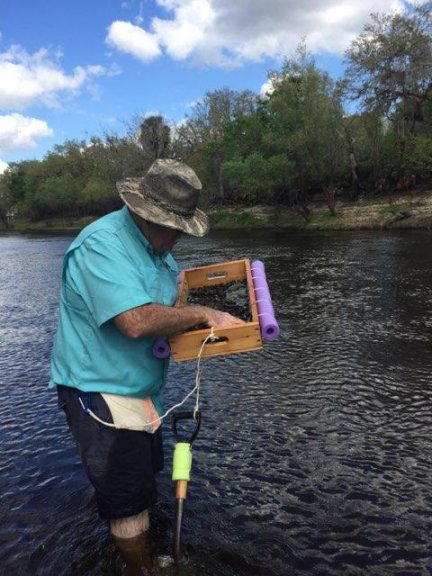 Here I am sorting through the material in the screen looking for fossils. Most of what is left in it is just misc. gravel, modern fresh-water mollusk shells, twigs and leaves. You have to look carefully at everything and
push around the stuff on the screen to see it clearly and from several angles to be sure to spot the fossils. Almost everything left in the screen is the same shade of dark brown or black. The fossils don't jump out at you
from their color like nuggets do in my other hobby of gold panning. You need to look for shapes, patterns and textures to separate fossils from non fossils. Some fossils like shark teeth can be obvious from their shape
if they aren't too broken or worn. Other fossils like bone fragments, and turtle shell pieces can do a good job of masquerading as rocks. It's only their texture and shape that can give them away to the experienced eye.
Here I am sorting through the material in the screen looking for fossils. Most of what is left in it is just misc. gravel, modern fresh-water mollusk shells, twigs and leaves. You have to look carefully at everything and
push around the stuff on the screen to see it clearly and from several angles to be sure to spot the fossils. Almost everything left in the screen is the same shade of dark brown or black. The fossils don't jump out at you
from their color like nuggets do in my other hobby of gold panning. You need to look for shapes, patterns and textures to separate fossils from non fossils. Some fossils like shark teeth can be obvious from their shape
if they aren't too broken or worn. Other fossils like bone fragments, and turtle shell pieces can do a good job of masquerading as rocks. It's only their texture and shape that can give them away to the experienced eye.
 Here I am taking a break from digging to rehydrate and sit on the bank to rest in the shade a while. Nothing like February in Florida. Temps in the 80s for heavy labor. Could be worse. Could be July. Fossil hunting
is hard work. First there's the paddling to the site. Then there's all the digging, screening and
sorting. Then there is the paddle back to the launch site and loading up. It can make for a grueling day, but super fun. My girlfriend really gets into it. I kept having to remind her to stop and drink occasionally.
When you find a good spot and each screen has nice fossils in it, it's hard to stop.
Here I am taking a break from digging to rehydrate and sit on the bank to rest in the shade a while. Nothing like February in Florida. Temps in the 80s for heavy labor. Could be worse. Could be July. Fossil hunting
is hard work. First there's the paddling to the site. Then there's all the digging, screening and
sorting. Then there is the paddle back to the launch site and loading up. It can make for a grueling day, but super fun. My girlfriend really gets into it. I kept having to remind her to stop and drink occasionally.
When you find a good spot and each screen has nice fossils in it, it's hard to stop.
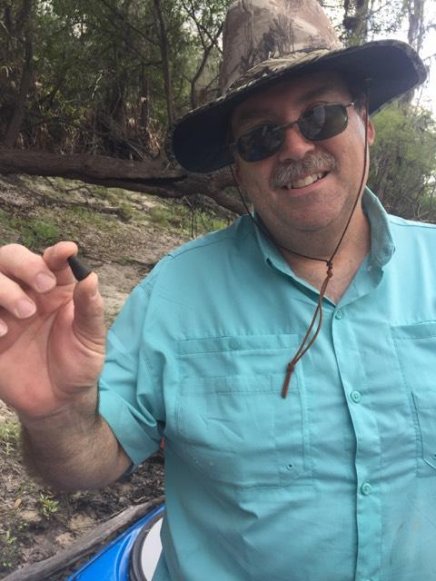 Here I am holding an alligator tooth my girlfriend found while I was taking a break. I got hit with the standard "You snooze you loose" line. Oh well, there's plenty more fossils in the river where that came
from. Besides, she gave me everything we collected today anyway. She's already got a huge fossil collection. Mine is growing fast too.
Here I am holding an alligator tooth my girlfriend found while I was taking a break. I got hit with the standard "You snooze you loose" line. Oh well, there's plenty more fossils in the river where that came
from. Besides, she gave me everything we collected today anyway. She's already got a huge fossil collection. Mine is growing fast too.
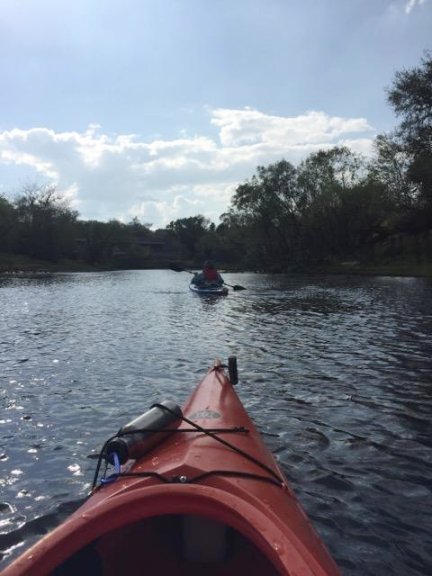 Here we are paddling back to the launch site after a day on the river. The wisdom of heading upstream first once again proves itself as the paddle back downstream was easy on us two tired fossil hunters.
After we loaded up and cleaned up a little, we headed into town to check out some antique shops then had dinner at a nice Mexican restaurant. It was a great day.
Here we are paddling back to the launch site after a day on the river. The wisdom of heading upstream first once again proves itself as the paddle back downstream was easy on us two tired fossil hunters.
After we loaded up and cleaned up a little, we headed into town to check out some antique shops then had dinner at a nice Mexican restaurant. It was a great day.
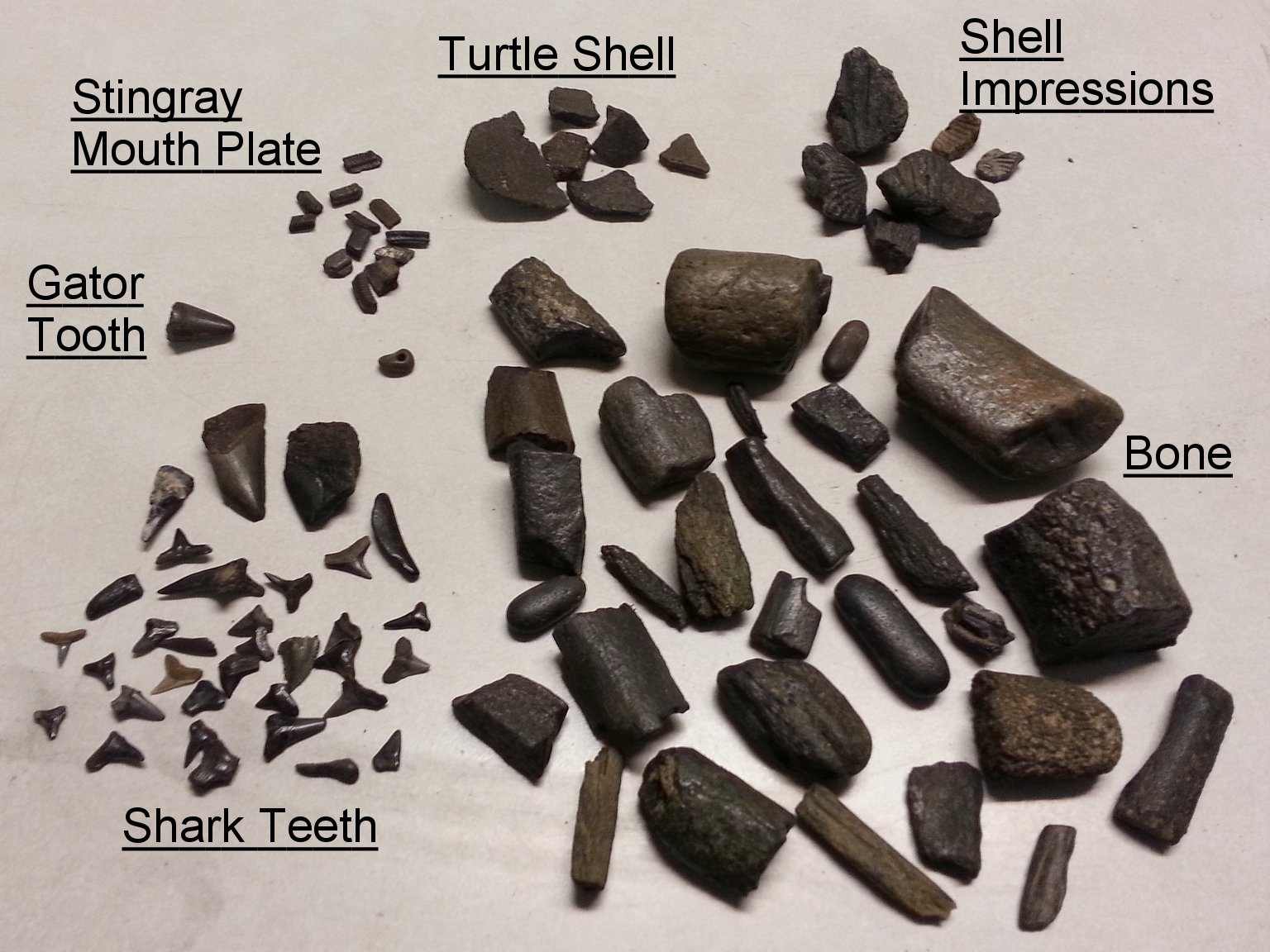 Here is a shot of all our finds from that day after cleaning, drying and sorting them. We found a whole lot of bone in this particular site. Some of those pieces of bone are 3 inches long, and more than an
inch in diameter. I need to start including a ruler or something for scale in these photos. The biggest pieces of bone are probably broken pieces of dugong ribs. The rest of the bone pieces are not as recognizable.
There are probably some misc. bones from other mammals, reptiles and some fish ribs. We'd really need to find more complete pieces to be sure what they came from. We found fewer shark teeth at this location than we
did on our last outing, but they tended to be larger and better preserved specimens here. Some hardly even look fossilized. We found two good sized broken Meg teeth and a large tooth we believe is from a Mako Shark.
There were also some whole mini meg teeth and a tooth possibly from a snaggletooth shark.
We also got some stingray mouth plate, but again it wasn't as plentiful as the last place we went. We also got some turtle shell and the gator tooth. We also found some really nice shell impressions in the limestone rock.
Here is a shot of all our finds from that day after cleaning, drying and sorting them. We found a whole lot of bone in this particular site. Some of those pieces of bone are 3 inches long, and more than an
inch in diameter. I need to start including a ruler or something for scale in these photos. The biggest pieces of bone are probably broken pieces of dugong ribs. The rest of the bone pieces are not as recognizable.
There are probably some misc. bones from other mammals, reptiles and some fish ribs. We'd really need to find more complete pieces to be sure what they came from. We found fewer shark teeth at this location than we
did on our last outing, but they tended to be larger and better preserved specimens here. Some hardly even look fossilized. We found two good sized broken Meg teeth and a large tooth we believe is from a Mako Shark.
There were also some whole mini meg teeth and a tooth possibly from a snaggletooth shark.
We also got some stingray mouth plate, but again it wasn't as plentiful as the last place we went. We also got some turtle shell and the gator tooth. We also found some really nice shell impressions in the limestone rock.
Click the photo for a larger view.
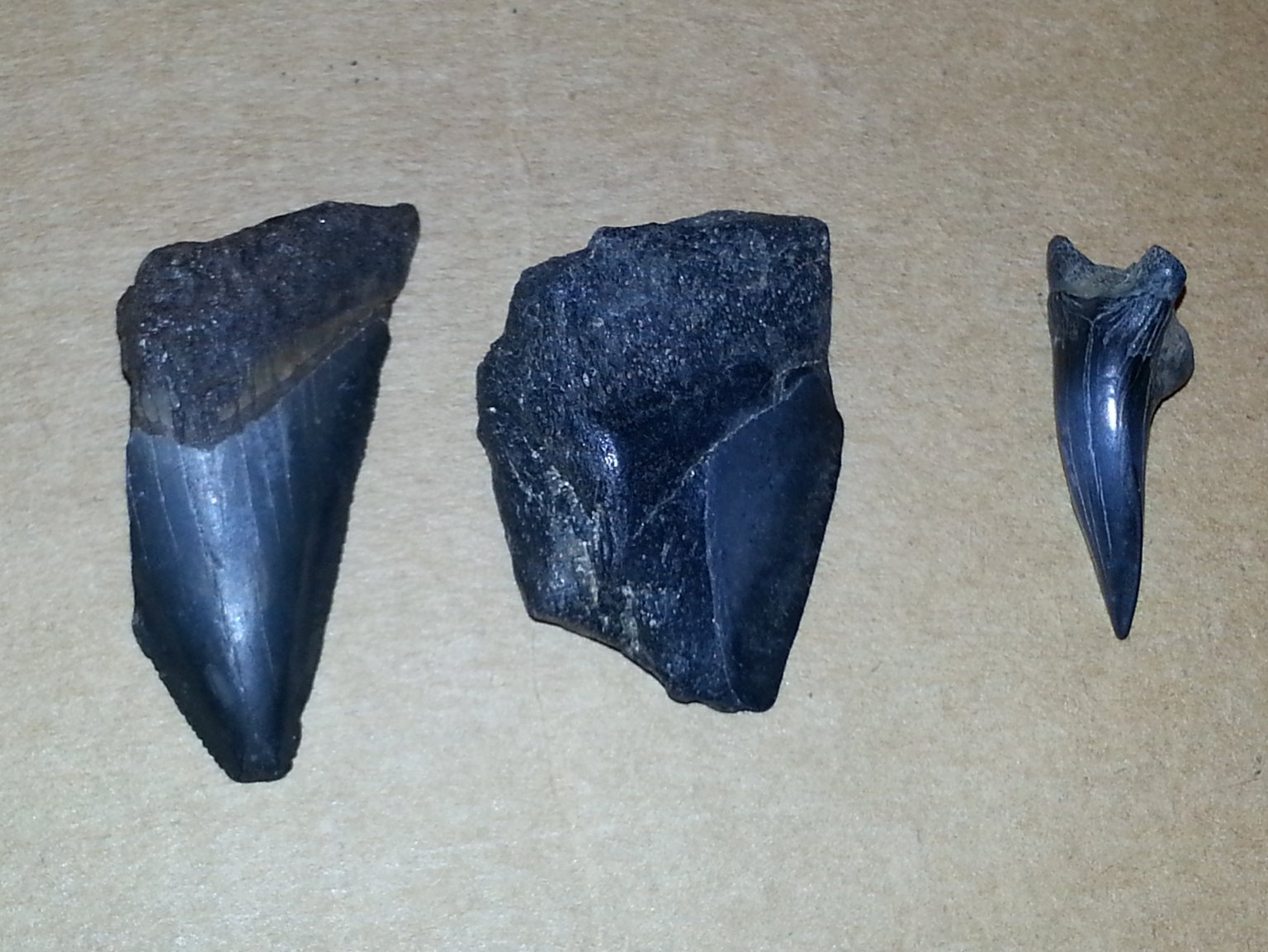 Here is a closeup of some of the biggest shark teeth we found. On the left is a nearly complete Meg tooth. In the center is a fragment from a much larger Meg tooth. I'd have liked to have found that one whole. On the right
is what we believe to be a Mako tooth.
Here is a closeup of some of the biggest shark teeth we found. On the left is a nearly complete Meg tooth. In the center is a fragment from a much larger Meg tooth. I'd have liked to have found that one whole. On the right
is what we believe to be a Mako tooth.
All in all, it was a great day of fossil hunting.
Click the photo for a larger view.
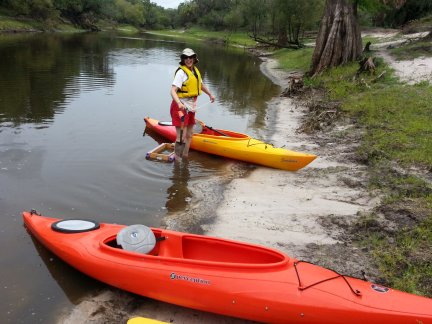 06/04/17 - A fossil hunt on the Peace River
06/04/17 - A fossil hunt on the Peace River
On Sunday my girlfriend and I went paddling up the Peace River in kayaks to go fossil hunting. Our original plan was to go on the Alafia River, but it was raining very heavily
where we planned to go. So we drove to a place on the Peace River she knew about. We put in at the Gardner Boat Ramp. We paddled upstream past the confluence of Charley Creek and kept
going. We went up stream quite a distance. We stopped at various places where the digging looked promising and sampled the gravels. We brought along screens and shovels and aprons with
pockets to hold our finds.
Here in this photo we have beached the kayaks at a likely looking spot to do some exploratory digging where a gravel layer seemed to be just under the river silt and sand. We probed the
river bed as we went looking for shallow gravel layers. We also stopped at exposed areas of gravel to dig. This particular spot was a bust. The gravel contained mostly sea shells. We
quickly learned that the dark black gravels produce the most fossils.
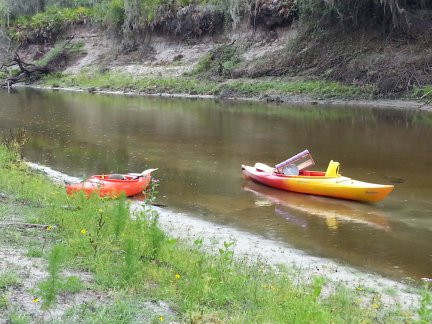 After paddling up river and stopping to dig in several places, we decided beach the kayaks and stop for lunch. It was a lovely spot. A real slice of old Florida with the gnarled oaks, pine
and cypress trees, all draped with Spanish Moss. We had a nice picnic lunch on the bank of the river before continuing on upstream.
After paddling up river and stopping to dig in several places, we decided beach the kayaks and stop for lunch. It was a lovely spot. A real slice of old Florida with the gnarled oaks, pine
and cypress trees, all draped with Spanish Moss. We had a nice picnic lunch on the bank of the river before continuing on upstream.
Eventually we found a really productive spot to dig. It just kept producing shark teeth, stingray mouth plate pieces and bone fragments. We eventually decided to pack it in and head
back downstream. This is where the wisdom of going upstream initially proved out. We let the current carry us back downstream. There was very little paddling required. Which was nice
because I for one was a little tired from all the paddling and digging.
When we reached the mouth of Charley Creek again, we decided to explore up it a little bit. The water was too shallow for the kayaks, so we waded upstream a few hundred yards and sampled
exposed gravels. We found another really productive spot and dug there for a while before calling it a day and heading back to the boat launch.
I didn't take very many photos on this trip. My phone spent most of the trip double plastic bagged and inside my backpack for safe-keeping. Good thing too, since I managed to dump myself into
the water a couple of times, and it rained on us a little too.
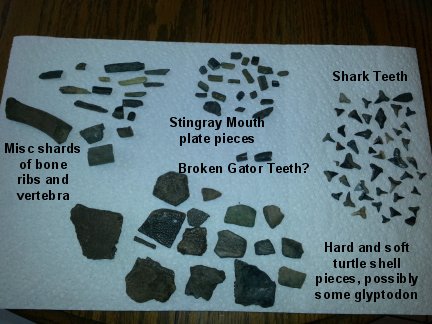 Here is a photo of the day's haul after drying them out and sorting them. Not bad considering we really didn't do that much digging. We found a lot of misc. pieces of bone. Some were recognizable
as vertebra. Some from fish and some possibly from mammals. There were lots of pieces that were probably pieces of ribs. Hard to say what animals they came from. Probably some fish and maybe some small mammals.
There was one large piece of bone that might be part of a leg bone from some large mammal. We found a couple of what look like broken alligator teeth. We found a lot of fossilized turtle shell from
both hard and soft shell turtles. Some of the pieces might actually be glyptodon shell. Further research is required. We also found a lot of pieces of stingray mouth plate. By far the greatest
number of finds were shark teeth. We found 45 whole and partial shark teeth ranging in size from tiny to pretty big.
Here is a photo of the day's haul after drying them out and sorting them. Not bad considering we really didn't do that much digging. We found a lot of misc. pieces of bone. Some were recognizable
as vertebra. Some from fish and some possibly from mammals. There were lots of pieces that were probably pieces of ribs. Hard to say what animals they came from. Probably some fish and maybe some small mammals.
There was one large piece of bone that might be part of a leg bone from some large mammal. We found a couple of what look like broken alligator teeth. We found a lot of fossilized turtle shell from
both hard and soft shell turtles. Some of the pieces might actually be glyptodon shell. Further research is required. We also found a lot of pieces of stingray mouth plate. By far the greatest
number of finds were shark teeth. We found 45 whole and partial shark teeth ranging in size from tiny to pretty big.
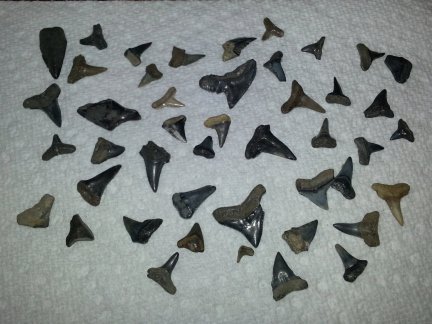 Here is a close-up of the shark teeth we found. They were very numerous. I suspect we probably lost a lot of tiny ones through the 1/4 inch mesh screen we were using. It is amazing how well they fossilize and
hold up over time. Some of them are still wicked sharp. Some of them have lots of tiny serrations still in place. They seem as like they could have been shed yesterday, but it has been a long time since
that part of Florida was under the sea. These teeth were fossilized in sea bottom mud that turned into rock. The river eroded them out of the rock and deposited them in gravel beds for us to find.
After all that time and getting beat up by erosion, they still look like new. Shark teeth are tough.
Here is a close-up of the shark teeth we found. They were very numerous. I suspect we probably lost a lot of tiny ones through the 1/4 inch mesh screen we were using. It is amazing how well they fossilize and
hold up over time. Some of them are still wicked sharp. Some of them have lots of tiny serrations still in place. They seem as like they could have been shed yesterday, but it has been a long time since
that part of Florida was under the sea. These teeth were fossilized in sea bottom mud that turned into rock. The river eroded them out of the rock and deposited them in gravel beds for us to find.
After all that time and getting beat up by erosion, they still look like new. Shark teeth are tough.
It was a great outing on the river. I am looking forward to doing it again. The rainy season is here now though and the rivers are running high. It may be winter before we can do it again.
